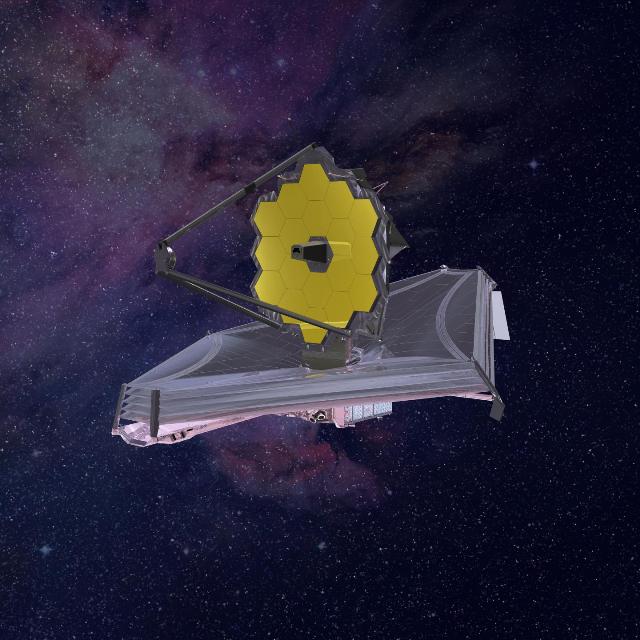Feb 9 2016
NASA's James Webb Space Telescope will look across vast distances to find the earliest stars and galaxies and study the atmospheres of mysterious worlds orbiting other stars. But the observatory also will investigate objects in Earth's own neighborhood - planets, moons, comets and asteroids in our solar system.
 In addition to looking at distant stars, galaxies and exoplanets, NASA's James Webb Space Telescope will investigate our solar system. Credits: Northrup Grumman
In addition to looking at distant stars, galaxies and exoplanets, NASA's James Webb Space Telescope will investigate our solar system. Credits: Northrup Grumman
These studies will help scientists understand more about the formation of the solar system and how Earth became capable of supporting life.
"The James Webb Space Telescope will be an innovative tool for studying objects in the solar system and can help take planetary science to a new level," said Stefanie Milam, the Webb telescope's deputy project scientist for planetary science at NASA's Goddard Space Flight Center in Greenbelt, Maryland.
Scheduled for launch in 2018, the Webb telescope will carry four science instruments to take images of and collect information about the physical characteristics and compositions of astronomical objects. Together, these instruments will cover the near- and mid-infrared parts of the spectrum, including wavelengths that are important when looking for water and other clues about the evolution and potential habitability of a planetary system.
From its vantage point a million miles beyond Earth, the Webb telescope will have a spectacular view of objects in the solar system. It will orbit the sun at a position called the Lagrange point 2, or L2, which will help to keep the telescope's temperature stable - instability distorts its view - and allows the large sun shield to protect the observatory from the light and heat of the sun and Earth.
Scientists envision using the observatory to monitor the water cycle on Mars, look at weather patterns on Saturn's moon Titan, and hunt for new rings around the giant planets. Comets could be tracked, and the water and gases they release during their journeys could be mapped. Ices and minerals could be identified on the surfaces of moons, asteroids and distant minor planets, helping researchers better understand the evolution of our solar system.
These and other possibilities are described in a 2016 special issue of the Publications of the Astronomical Society of the Pacific, with Milam serving as the guest editor. A total of 11 papers were contributed by authors from across the planetary science community, with Goddard scientists taking the lead on how to use the Webb telescope to study Mars, Titan and near-Earth objects.
From a technical standpoint, some adjustments have to be made when studying planetary objects, which can be a very different proposition from looking at an extremely distant star or galaxy.
"We're taking an instrument designed to detect the faint light from the first stars of the universe and instead using it to look at the brightest objects in the sky - and objects that move fast with respect to objects outside of our solar system," Milam said.
To observe planets and other bright bodies, scientists will be able to reduce the amount of light by reading out smaller portions of the detectors very rapidly or by filtering out all but a few wavelengths of light. For moving targets, the entire telescope will move, using non-linear tracking to follow objects along curved paths - a more realistic motion that yields better accuracy.
The authors estimate that from its orbital position, the Webb telescope could have access to observe nearly three-fourths of the near-Earth object population each year. Nearly all asteroids and comets beyond Mars could be observed, as well as all but the three innermost planets - Mercury, Venus and Earth. The observatory also will be able to see minor planets and other objects beyond Neptune - and even watch them cross in front of nearby stars.
"The Webb telescope will make it possible to observe many objects that are too small, too distant or too faint for ground-based instruments," said John Stansberry at the Space Telescope Science Institute in Baltimore. "The truly exciting opportunity is that we will be able to determine basic physical characteristics - shape, size, reflectivity - for a whole catalog of these objects and to conduct very sensitive measurements of their compositions."
Global studies will be possible, because the Webb telescope will be able to image the entire disk (or face) of many planets, moons and small objects with high resolution. This will help scientists map water, carbon dioxide, methane and other gases, to see how the atmospheres of planets (or moons) change from season to season or when night falls - and to detect sudden plumes of gases that might warrant further investigation. Some investigations could even be detailed enough to look at emissions from individual volcanoes on Jupiter's moon Io.
Studies like these will help scientists refine their models of how our solar system formed and evolved to support life.
"There are still many questions to answer right here in the solar system, and by answering them, we will better understand what we observe in other planetary systems," Stansberry said.